Have you ever heard of Kangaroo Care? Not all prematurely born babies need to be hooked to machines to survive – in fact, they may just do better skin-to-skin on Momma’s chest with less possibilities of accidental harm to them or side-effects.
I was enthralled by the story of a 27-week premature baby coming back to life after being lovingly cuddled skin-on-skin.
Kate and David Ogg told how doctors gave up on saving their son after a three-hour labor in a Sydney hospital and doctors had pronounced him dead
Watch and listen to Dr. Susan Ludington explain what happens medically! This is beautiful. 4 minutes.
Skin-On-Skin (Kangaroo Care) Is Life-Giving
It seems kangaroo care is a practice that is coming into its own after remarkable results in places like Bogata, Columbia. Midwifery Today explains it well:
“By the early 1980s, the mortality rate for premature infants in Bogota, Colombia was 70 percent. The babies were dying of infections and respiratory problems as well as lack of attention paid to them by a bonded parent. “Kangaroo care” for these infants evolved out of necessity. Mothers of premature infants were given their babies to hold twenty-four hours a day-they slept with them and tucked them under their clothing as if in a kangaroo’s pouch. If a baby needed oxygen, it was administered under an oxygen hood placed on the mother’s chest.
“Doctors noticed a rapid drop in neonatal mortality. Babies were not only surviving, they were thriving. Currently in Bogota, babies who are born as early as ten weeks before their due date are going home within twenty-four hours! The criteria for these babies is that they be alive, able to breathe on their own, are pink and able to suck. However, their weight is followed closely.
“Dr. Susan Ludington is one of the people who have been most instrumental in bringing kangaroo care to the United States. Her work is having a powerful, positive impact on premature babies and their families. In the United States, the few hospitals that regularly use kangaroo care protocols have mothers or fathers “wear” their babies for two to three hours per day, skin-to-skin. The baby is naked except for a diaper, and something must cover his or her back—either the parent’s clothing or a receiving blanket folded in fourths. The baby is in a mostly upright position against the parent’s chest.”
Kangaroo Care Benefits
The benefits of kangaroo care are numerous:
- The baby has a stable heart rate (no bradycardia),
- more regular breathing (a 75 percent decrease in apneic episodes),
- improved oxygen saturation levels,
- no cold stress,
- longer periods of sleep,
- more rapid weight gain,
- more rapid brain development,
- decreased crying,
- longer periods of alertness,
- more successful breastfeeding episodes,
- and earlier hospital discharge.
Benefits to the parents include:
- “closure” over having a baby in NICU;
- feeling close to their babies (earlier bonding);
- having confidence that they can care for their baby, even better than hospital staff;
- gaining confidence that their baby is well cared for;
- and feeling in control—
- not to mention significantly decreased cost!
Heart Rate, Respiratory, Body Temp, Weight Gain: All Stabilize
Why does kangaroo care work? Why are Dr. Ludington and others seeing such phenomenal results with babies in kangaroo care? What is happening to the baby and the mother during this time?
1. Mothers naturally modulate the warmth of their breasts to keep their infants at the optimal temperature where babies sleep best, have the best oxygen saturation levels, the least caloric expenditure, and so forth.
Maternal breast temperature can rise rapidly, then fall off as baby is warmed. As the baby starts to cool, the breasts heat up again—as much as 2 degrees C in two minutes!
2. Being next to mom also helps the baby regulate his or her respiratory and heart rates. Babies experience significantly less bradycardia and often, none at all. The respiratory rate of kangaroo-ed infants becomes more stable.
3. Apnea, (temporary suspension of breathing, occurring in some newborns) decreases four-fold and often disappears altogether.
If apneic episodes do occur, the length of each episode decreases. In my own experience with a baby in NICU for bradycardia and apnea, I found that both problems disappeared completely when I was home kangaroo-ing my baby.
4. These babies gain weight faster than their non-kangaroo-ed counterparts, and it is interesting to note that they usually do not lose any of their birth weight. This is in part due to the baby’s ability to sleep, thus conserving energy and putting caloric expenditure toward growth.
According to Dr. Ludington, during the last six weeks of pregnancy, babies sleep twenty to twenty-two hours per day. In a typical NICU, however, they spend less than two hours total in deep, quiet sleep. Most of that comes in ten or twenty second snatches.
With kangaroo care, the infant typically snuggles into the breast and is deeply asleep within just a few minutes.
5. Researchers have gained significant insight into what happens to an infant’s brain during kangaroo care. Any baby’s heart rate and respiratory rates can be plotted as a sort of artistic drawing. Because premature infants lack the ability to coordinate their breathing and heart rates, the rates “plot out” as chaotic. This means with increased demand on the cardiovascular system, as with crying or fussing, the system does not respond with a related increase in cardiac output. In other words, the baby’s respiratory rate may increase while crying, but the heart rate does not. As preemies mature, these rates become synchronized, or “coupled,” resulting in an orderly drawing when the rates are plotted together. The drawing no longer looks random.
Imagine the implications if all infants “at risk” were kangaroo-ed. Dr. Ludington sums up kangaroo care very aptly by saying “Separation is not biologically normal.”
Summary
All infants benefit from skin-to-skin contact, breastfeeding, shared sleep and so forth, but some babies very seriously need kangaroo care. They include premature infants, infants with low muscle tone or disabilities, high-needs infants, those with intrauterine growth retardation or those who have a hard time gaining weight.
Kangaroo care can also be done by fathers and others willing to help in the event a parent cannot. Sick and normally healthy babies benefit. Everyone benefits.
It’s also known that kangaroo care can work in the reverse to bring a mother back to life!
If you know of anyone who has a newborn or older baby struggling with health issues, please share this concept with them. Also, I would do this for the colicky baby!
It will make a profound difference!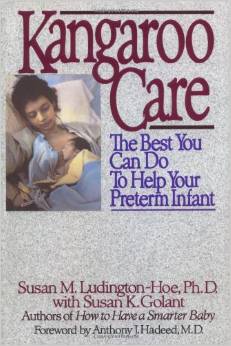
Dr. Susan Ludington’s book Kangaroo Care: The Best You Can Do to Help Your Preterm Infant is available for parents or caregivers of preterm infants not familiar with this wonderful ‘biologically normal’ practice.
©2024 Deep Roots at Home • All Rights Reserved



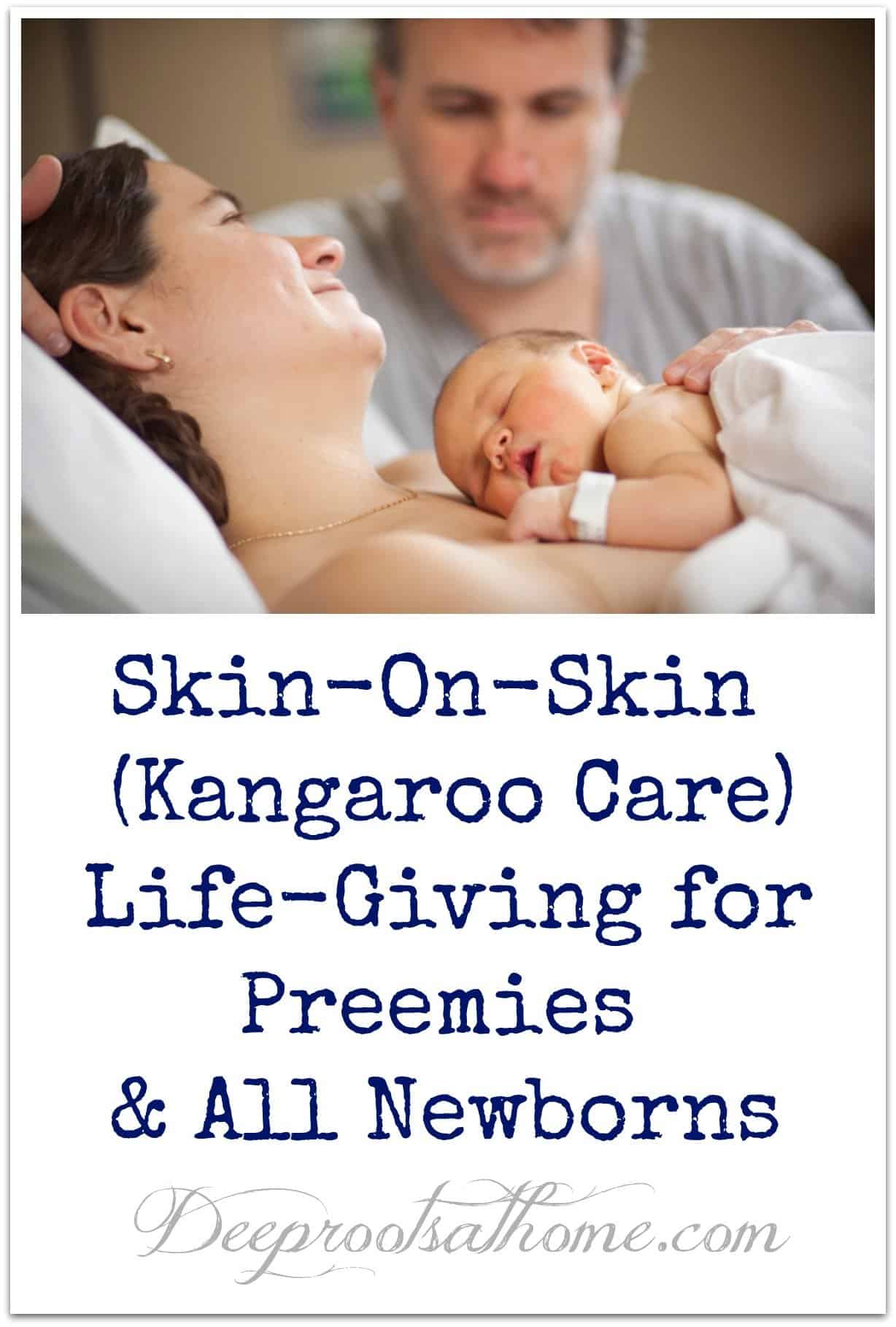

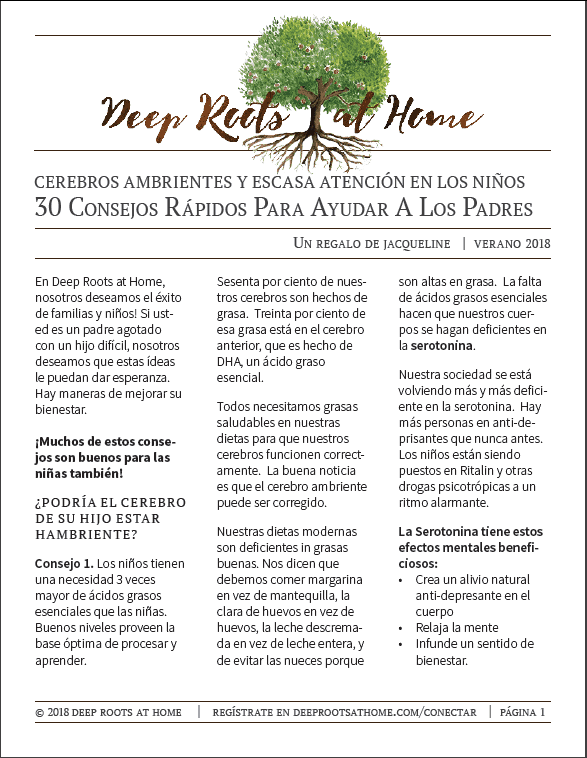

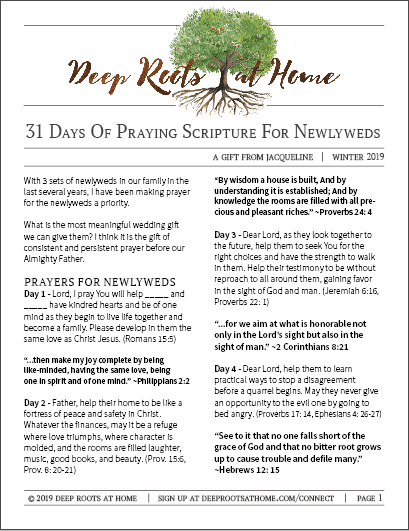
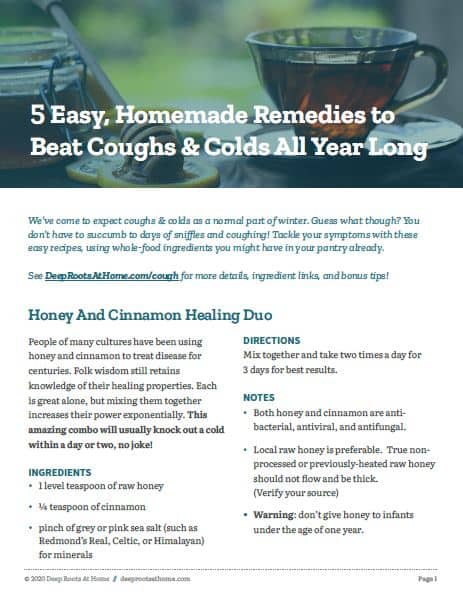
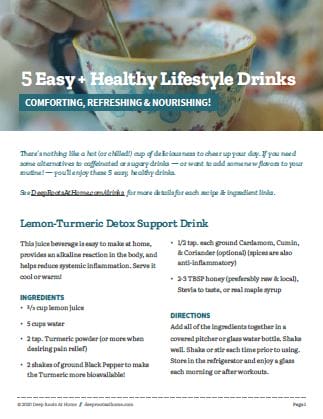
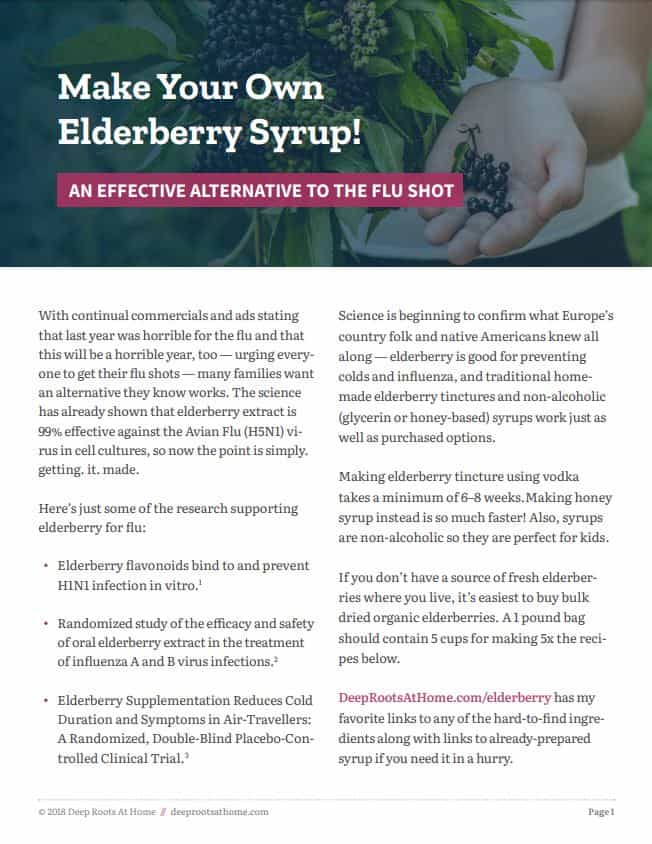

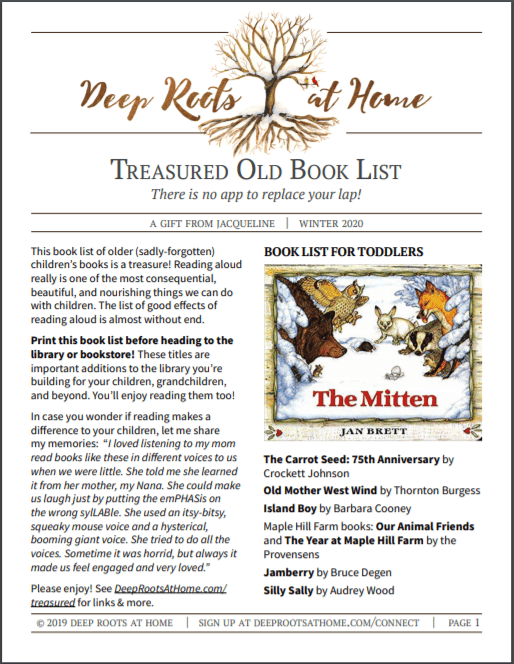
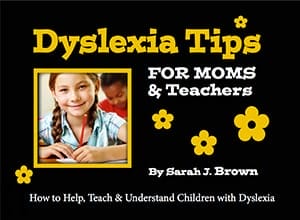
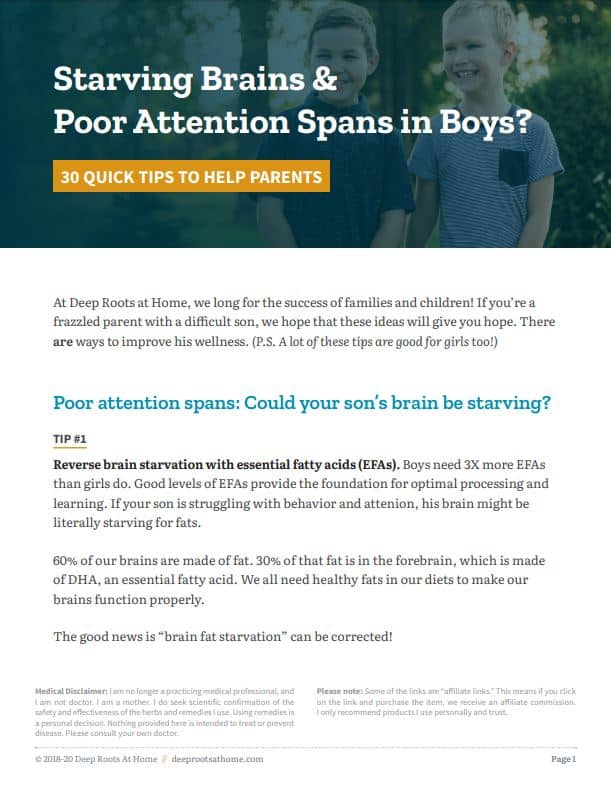

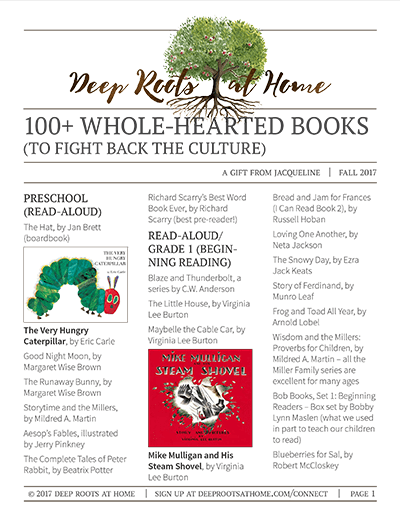
Gabby
I love this post! The hospital I used to work for (before moving to another state) REALLY encouraged Kangaroo care. In fact, it was even “scheduled” daily (it depended on each patient, of course). As a new-er nurse, I was a bit concerned (scared?) about the entire idea, but as the months went by, I really saw the benefits of it! 🙂
Jacqueline
Gabby, thanks for sharing that experience. I know now (as a seasoned mom) that this would be awesome for babies that for whatever reason aren’t settling into routine or aren’t thriving. I wish I had done it for our colicky babies.
May the Lord bless you…have an amazing weekend!
Amy @ No Greater Honors
My only experience with any kind of ‘kangaroo care/skin-to-skin’ was with my youngest son. I remember when he was born, his breathing was not what you’d expect – he almost sounded as if he had too much water that didn’t suction out well, and he was working harder than he should have had to breath, while not getting as good a breath as he should. Honestly – my thought wasn’t “Oh, I know how to fix that!”. What I knew was, the nurse said she may have to take him to the NICU if it didn’t get better soon, and I wasn’t ready to hand over my baby. I already had a 4-day stay with a baby in the NICU under my belt years before, when my oldest son was born sick. I remember just wanting to hold my little guy, and the fact that he was on my chest didn’t occur much to me – until about 20 minutes after his birth, when the nurse mentioned that he sounded as if he was just fine now. It wasn’t until later that I thought about putting two-and-two together, and I am a firm believer in that skin-to-skin contact 🙂 Great article!
Jacqueline
What a wonderful story! I’m so thankful for your son’s quick turnaround! A mother’s instinct is a wonderful thing, but sometimes we need to be purposeful! Blessings to you! 🙂
Mrs. Abella
I agree with most of the post. Kangaroo care is a great thing for preemies! It helps parents and baby bond, especially during NICU stays when the baby is not able to be with mom/dad all the time.
I will go on to say that kangaroo care does *not* cure all the ailments you find in the NICU. It helps, yes, but it isn’t a cure all.
My son stayed 89 days in the NICU. He was born 3 months preemie due to pre eclampsia. He weighted 1 pound 5 ounces. He had bradycardias up to 47 times a day. He stopped breathing constantly. He had multi organ failure. He had pneumonia, a lung collapsed, he got other infections. He also had inguinal hernias, and reflux like no tomorrow and had surgery at 2 months old (still a month before due date) while in the NICU to help with the reflux and correct the hernias. His lungs at birth were not developed well and even with surfactant, he needed the vent. He was on some sort of oxygen, whether vent, cpap, or cannula, for 82 days of 89. He learned to eat with a bottle in the last 2 weeks of his stay. He came home at 5 pounds. During his stay, I did kangaroo care when he was strong enough to be allowed out from incubator. I couldn’t be there every day due to finances and such–remember 3 months of stay there. By the grace of God he made it, and now 12 1/2 years later he’s a big strapping near-teenaged boy who’s taller than I am and strong as an ox, and no physical problems. He has autism/MR/bipolar disorder, we believe most likely from the lack of oxygen at and just before birth…either way, he’s still my booger and he wouldn’t be who he is any other way.
Jacqueline
Thank you for your precious story, Mrs. Abella. I agree that it does not cure all the ailments. That is why I said ‘strengthens’ premies. And sometimes they are just too weak or there are just too many wires to dislodge. I am so thankful your son is who he is! Awesome 🙂
Blessings!
Abby
This is fascinating. My grandson was just born 3 weeks early, although a robust 7 lbs, 1 oz. and healthy. Thank you for sharing this wonderful insight into yet another aspect of the miracle of birth.
Emily Lynn
I desperately wish I had done some research on premie care before our first child was born. I read voraciously about home birth, avoiding a c-section, natural baby care, etc. but because I was determined to stay healthy through the pregnancy, I didn’t want to think about our baby coming early. Six weeks before my due date, I went into labor. I did not have any indication of trouble before that day, and the ER doctor could not determine the cause of early labor. Our sweet daughter was born 4lbs 6oz and got down to 3lbs 15oz before gaining weight steadily. I wish I had known about kangaroo care, because the hospital did not discuss that option with me. The day after her birth I was able to hold her, but she stopped breathing after only a couple of minutes and the nurse whisked her away again. I was not able to hold her for any length of time for the first 4-5 days, and she continued to have apneic episodes through the second week. We were in the hospital for three weeks. Thankfully, she needed no major interventions–she was on forced room air for the first 48 hours, then just a biliblanket and a monitor. We were very blessed that she was so healthy, and I am so grateful to God for her! She is now a healthy 9 month old scooting all over the house 🙂
Jacqueline
Emily Lynn,
That she is so healthy is awesome! I praise God right along with you 🙂 It is amazing how an incident like that can make us realize the brevity and preciousness of life!
Many blessings to you and your little one.
D'Ann
My husband and I have been blessed with 10 children, aged 2 to 18. When he was only a few months old, one of our sons came down with a virus that produced a high fever and respiratory distress. We prayed for wisdom and maintained skin-to-skin contact with him throughout that night, resulting in a drop in his fever and a regulation of his breathing. Even though his condition had so dramatically improved, we chose to continue kangaroo care for a few days, since the virus was being shared among our other 6 children. He showed no more symptoms and had no lasting effects, which could have been traumatic to such a young life.
We were prepared to whisk our baby boy to the Emergency Room, had his fever continued to rise. How we praise our Lord for the healing He gave without the intervention of medicines or strangers! Thank you for posting this article. I sincerely hope it will give parents another tool in their arsenal of health care answers.
Jang
What an encouraging and inspiring story! God is so good. I did not know this is called Kangaroo Care but this is widely practice here in the Philippines. I am also pregnant and just waiting for my delivery this week or maybe next week, I am praying for a normal delivery. Thanks for sharing this post Ma’am Jac =)
Jacqueline
Jang, I am praying for you and this little one you carry. The Lord is good, and I trust you will have a wonderful experience and a healthy baby. May the Lord richly bless you 🙂
Rhonda
This information used to be part of the American medical knowledge. When my grandmother and her identical twin were born prematurely in 1911, their mother had pockets sewn inside her clothes to carry them around in. I can’t remember how much they weighed at birth but once grown neither woman was very big, around 5 feet tall. My grandmother lived until she was 96 years old. My aunt lived until she was 98.
Jacqueline
Thank you, for sharing this age-old wisdom, Rhonda! It is true! Sadly, ther has been so much dumbing down and many today just don’t care! We need to stand the ground and teach as best we can the old paths! Jeremiah 6: `6 says: “Thus says the LORD, “Stand by the ways and see and ask for the ancient paths, Where the good way is, and walk in it; And you will find rest for your souls. But they said, ‘We will not walk in it.'”
Blessings!
lyss
This is so fascinating! I’ve heard of tiny premature babies in third world countries surviving, without hospitals and isolettes, and have wondered how? This must be how. Amazing.
I had a 3 1/2 lb. preemie, and while kangaroo care was mentioned, I don’t remember hearing how truly important and beneficial it is. Thankfully, even with only daily visits, and doing skin on skin care only a few times, our son came home after 5 weeks with no lasting problems. I can’t help but wonder if we had really taken kangaroo care seriously… Even after coming home, he was still under 5 lbs, and his first year was very slow to grow. Now I know that wearing him would have been beneficial, as would have supplementation. His pediatrician, while I’m sure a good doctor, I don’t think had much experience with preemies. “He’s underweight….give him pediasure.” Now I know some things I would have done differently, but I’m so thankful that God takes care of us even when we don’t know what to do. Our boy is now a happy, healthy 5 year old, even with a rough start in life and a mama who didn’t know what she was doing! : )
Jacqueline
Lyss, It truly is amazing how it will perk a baby up! It is truly a miracle how God designed the mother/child relationship. There is great POWER in loving touch! So thankful your son is thriving now 🙂 Blessings!
Lisa
My daughter, just days shy of her 21st birthday, was born 6 weeks prematurely. Amazingly, she was 5lbs and able to come home after just two extra nights in the hospital. While there, she was under lights and wrapped up for the times I could hold her to feed her. I wish I had known even then how important Kangeroo Care was. Once home, nursing her was difficult because she was so little and sleepy…she just kept falling asleep. Thankfully, I immediately called our lactation specialist and she advised me to nurse my daughter skin to skin to keep her awake. It was marvelous. The skin to skin stimulated her to stay awake and suck, and at her two week check up she had gained a pound! She never looked back. This May she completes a four year degree in three years and in July, praise God, she will be married!!!
By the way, I absolutely love your blog. I think it is my favorite…your meekness above all is so appealing and encouraging. And we share many attitudes and interests. Thank you so much for writing here.
Jacqueline
Oh, How you encourage me, Lisa! Oh, thank you so much. I often feel the weight of trying to be helpful and falling far short 🙂 BUT, we have an Awesome God! He makes us to be His vessels and gives us hope!
I am so thrilled to hear how the skin on skin stimulated your sleepy little girl 🙂 And congratulations on her graduation and up-coming wedding! How lovely! I am praying a blessing on them even now.
Suzie@homemaker-mom
I had never heard of this before. This was simply amazing to read.
Jacqueline
Yay! I loved learning about this technique and am glad to help get the word out, Suzie 😀
Janice Wald
Hi Jacqueline,
It’s wonderful what modern medicine can do to help people like these babies.
My husband is supportive of my blog too.
Thanks for bringing your post to the Blogger’s Pit Stop.
Janice, Pit Stop Crew
Kathleen - Bloggers Lifestyle
Like most of your posts, this is an ‘evergreen’. We will feature it in the next Blogger’s Pit Stop.
Kathleen